 Ted Koppel was ABC’s State Department correspondent when he got a call on Sunday, November 4th, 1979 asking him to come into the studio to report on a developing story in Tehran. Hundreds of radical students had seized the U.S. Embassy denouncing it a “nest of spies” and holding its staff hostage. Koppel was certain the situation would be dispelled quickly, but as the days went on it soon became clear that there would be no speedy resolution and ABC saw an opportunity in the public’s appetite for the story. In response the network created a dedicated nightly program to cover the crisis—Nightline: America Held Hostage—which would eventually become Nightline. GQ’s Sarah Goldstein interviewed Koppel for our oral history of the crisis. Here he talks about media coverage of the crisis and how a story he didn’t want changed his life.
Ted Koppel was ABC’s State Department correspondent when he got a call on Sunday, November 4th, 1979 asking him to come into the studio to report on a developing story in Tehran. Hundreds of radical students had seized the U.S. Embassy denouncing it a “nest of spies” and holding its staff hostage. Koppel was certain the situation would be dispelled quickly, but as the days went on it soon became clear that there would be no speedy resolution and ABC saw an opportunity in the public’s appetite for the story. In response the network created a dedicated nightly program to cover the crisis—Nightline: America Held Hostage—which would eventually become Nightline. GQ’s Sarah Goldstein interviewed Koppel for our oral history of the crisis. Here he talks about media coverage of the crisis and how a story he didn’t want changed his life.
GQ: Tell me about when you first got the call to start reporting this story.
Ted Koppel: This would have been the day the hostages were taken—November 4, 1979. It was a Sunday, as I recall, and I was home. In those days, I was senior diplomatic correspondent for ABC News. The guy who was on the desk that day was a fellow by the name of Frank Radice. Frank said that someone had broken into the US embassy in Tehran, that they appeared to be holding some hostages, and would I get into the State Department and find out what was going on? I reminded him that the same thing had happened just a few months earlier and that it had been broken up within a very short period of time, and that I was sure that the same thing was going to happen here, and I was damned if I was going to give up my Sunday. He said, “No, I really need you to come in. We need a piece for the news tonight.” And so grumping and grumbling all the way, I went in, and I did a piece on it that night in which I said essentially the same thing: This kind of thing has happened before and is likely to be over very soon.
GQ: At what point did you and the producers realize that the embassy seizure was actually not going to end quickly, and that it was a much larger story than you’d initially thought?
TK: For the first two or three weeks, as I recall, the White House was having briefings twice a day. President Carter famously said the hostages were the first thing he thought about in the morning and the last thing he thought about at night. It was a downright foolish thing to say, because it made the people holding the hostages realize that they had an awful lot of influence over the United States.
So we did these nightly reports, and after two or three weeks, the White House began to realize that this was not reflecting all that well on the president, who was about to run for reelection. Soon there was only one briefing a day. And instead of eagerly seeking stories they began to sort of clam up a little bit. And something similar was happening in Tehran–there were days when nothing was going on! And we would say to Roone [Artledge, the executive producer] “You know, we don’t think we can do a program tonight.”
GQ: You were a correspondent then.
TK: Yes, I was chief diplomatic correspondent. I’d be on the evening news and then I’d be on the late night news at 11:30. And these programs were infamously called “America Held Hostage: Day 5,” Day 7, Day 20, etc. And then one day I remember being on the phone with Roone saying, “You know, there’s nothing going on today. I mean, we really shouldn’t even be doing a special tonight.” And Roone said, “Tell me what a mullah is. Tell me what an ayatollah is. Explain the difference between Shia and Sunni.”
GQ: So he told you to be creative.
TK: He told us to be creative




